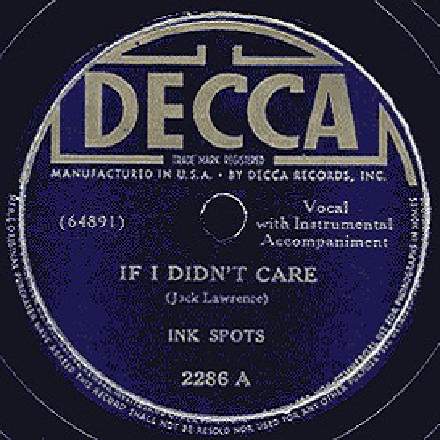
Although this song is one of the best-selling singles of all time, a lot of readers probably haven’t ever heard it, seeing as it dates from 1939! However, as a long-term fan of The Ink Spots, I’d recommend seeking out at least this one song if they’ve so far passed under your radar, if only to admire a lyric comprised entirely of questions and snigger at the earnest deployment of the phrase “honey child”! And should you like ‘If I Didn’t Care’, you’ll probably be partial to their other hits, too, because most of them follow an almost identical format — so much so, in fact, that it almost strains credulity these days. Skip forward, for instance, seven years to their 18th US top ten ‘Gypsy’, and you’ll find the same guitar, piano and string-bass backing band; the same high falsetto lead vocal from Bill Kenny; the same three-part backing ‘oohs’; the same softly rumbling, spoken middle section; and even the same dinky little guitar intro riff.
While, from a purely commercial perspective, there’s a lot to be said for the ‘if it ain’t broke’ principle — if nothing else, their brand recognition is peerless! — I imagine there were also significant practical advantages to maintaining such a consistent musical format given that the band’s heyday predated the mainstream adoption of any kind of multitrack recording technology. If you’re working in mono and there’s no such thing as a mixdown stage, you need an arrangement that mixes itself. So it’s no coincidence that nothing in this production presents any serious competition to the lead vocal, sonically speaking, but that each of the backing parts nonetheless has its own means of remaining audible: the piano and guitar have their transients, the bass and piano have the low end, and the BVs can bubble up during gaps in the lead.
Notice also that the string-bass part drops out during the middle section, which, from an arrangement perspective, makes sense because it clears out some of the LF spectrum to accommodate Hoppy Jones’s rich bass tones, conveniently inflated by the (presumably ribbon) mic’s powerful proximity bass boost. However, I suspect that there was also another dimension to this decision, because Hoppy was also the bass player. Although I was unable to find any specific recording information about this particular session, I’d bet my bottom dollar that he had to abandon his instrument and sneak forward to Bill Kenny’s mic for this vocal — in fact, on my CD re-master I’m pretty sure I can actually hear his furtive footsteps just prior! (I reckon he didn’t make it back to his place in time afterwards, either, because the bass is a few beats late rejoining the mix on Bill’s return.) His backing vocal drops out too, but of course you don’t notice that because Kenny has surreptitiously drifted back into the room to fill the breach.
One nice technical detail to savour for nostalgia-lovers: if you listen carefully to the song’s final line, you can faintly hear both a pre-echo and a post-echo of “would all”. It’s not some kind of pioneering experiment in effects processing, though, but rather the magnetic print-through from one strongly modulated layer of the analogue master tape to its immediately neighbouring layers on the reel.
Another thing: there’s an interesting issue here with the bass. Apparently Hoppy Jones regularly used to use a cello rather than an upright bass for his bass line when performing. I can see how this would have made sense back in the day of severely bandwidth-limited transmission, because you’d have got more tone from that instrument in the midrange in terms of communicating the musical function of the bass line to the listening – at the expense of real LF weight, though this would of course rarely reach the listening anyway. However, as far as this particular recording goes, my spectrum analyser suggests they used a proper bass in this instance. Perhaps it’s the extra unwieldiness of the larger instrument which contributes to Hoppy’s late uptake at Bill’s re-entry – assuming I’m hearing that correctly.
Finally, it’s interesting line to draw between this track and Taylor Swift’s 'We Are Never Ever Getting Back Together' too, because they both use spoken (not rhythmically rapped) middle sections, which are very much a rarity these days.










